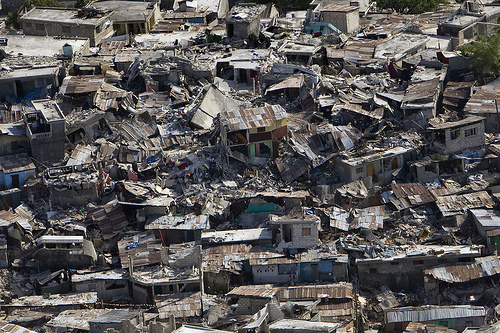 Since I lived in New Orleans at the time Hurricane Katrina hit, I can easily tell you the ways that social media have advanced in the past 4.5 years, and how those developments greatly impact news coverage of a disaster. The surge of popularity in Facebook and Twitter alone is huge. These two sites are enabling citizen journalism from Haiti — despite its status as one of the poorest countries in the world. The sites are also aiding established news providers with ways to allow better coverage. Before professional reporters could safely travel to the country, the only way to get information was from the people directly affected by the earthquake.
Since I lived in New Orleans at the time Hurricane Katrina hit, I can easily tell you the ways that social media have advanced in the past 4.5 years, and how those developments greatly impact news coverage of a disaster. The surge of popularity in Facebook and Twitter alone is huge. These two sites are enabling citizen journalism from Haiti — despite its status as one of the poorest countries in the world. The sites are also aiding established news providers with ways to allow better coverage. Before professional reporters could safely travel to the country, the only way to get information was from the people directly affected by the earthquake.
Here are some of the ways social media has come into play:
- Some of the first photos of the devastation were released via Twitter. A Haitian journalist named Carel Pedre took them and sent them to his friend in Miami to post.
- The New York Times’ blog, The Lede, offers everything from staff reports to user-submitted photos via TwitPic.
- NPR has been collecting and sharing information from listeners on its Facebook page. Media Bistro’s BayNewser blog did an interview with NPR’s social media strategist, Andy Carvin, about how the organization decided which information to share and why its social media outlets are so successful.
- The Red Cross has been sending numerous updates through its Twitter account, @Federation.
- CNN’s iReport, a large outlet for citizen journalism, has a page devoted to the earthquake.
- Global Voices, an online community of more than 200 bloggers, created a digest of both blog posts and tweets on the topic.
Fundraising efforts and relief coordination are being influenced by social media, too. In the U.S. alone, cell phone users have raised $8 million through a “Text Haiti” campaign, which has been publicized mostly through word of mouth. You can text the word “HAITI” to 90999 to donate $10 to the Red Cross; the charge will be reflected on your next cell phone bill. Mashable has also compiled a list of other ways to donate on the web and via SMS.
Business Week reports on other fundraising efforts:
Twitter and Facebook have helped spread the word about ways to donate, said Wendy Harman, the social-media manager for the American Red Cross. […]
‘The level of tweeting and posting to Facebook is beyond anything we’ve ever seen before,’ said Harman, who joined the organization in 2006 for the new position centered on social media. ‘We’re turning to these cultural tools for good rather than just talking.’
At the British Red Cross in London, which has collected 1 million pounds ($1.6 million) for the disaster online, social media ‘is definitely one of our priorities,’ said Sarah Webb, its digital fundraising manager.
‘It’s very immediate, which is obviously important in emergency situations,’ she said.
The U.K. aid group Oxfam had collected about 34,000 pounds via an embedded link in a YouTube video posted the day after the quake. A similar link, in a Twitter post the night of the tremor, got about 5,000 hits, said Sarah Brown, who is responsible for social media for Oxfam in Oxford, England.
Hopefully, social networking sites will make it a little easier for victims of the earthquakes to locate family and friends, as this was definitely a challenge in the aftermath of Katrina. Various sites have put up pages to help locate victims of the tragedy, such as The New York Times.
SOURCE: “Social media amplify American response to Haiti’s tragedy,” WorldFocus, 01/15/10
SOURCE: “Haiti Fundraising Speeds Up With Twitter, Facebook,” Business Week, 01/15/10
SOURCE: “$2 Million in Donations for Haiti, via Text Message,” The New York Times, 01/13/10
SOURCE: “Covering Haiti,” Fishbowl NY, 01/15/10
Image by United Nations Development Programme on Flickr, used under its Creative Commons license.